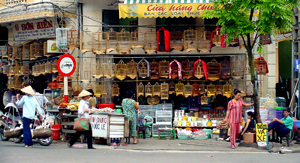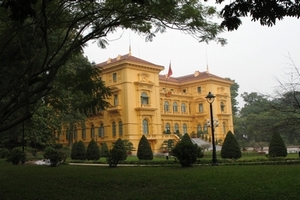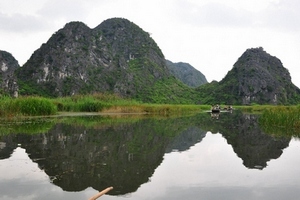Home > Asia > Vietnam > Travel Ideas > Hanoi



VIETNAM 越南
Hanoi (河內)
Hanoi is arguably Asia's most charming capital city. Hanoi, meaning "where the river bends' is a city of broad, tree-lined boulevards, elegant French villas and colonial-era buildings painted in muted hues of yellow and orange.It is also one of Asia's greenest cities with an abundance of parks and lakes as well as a host of cafes and art galleries and an Old Quarter steeped in history. By day the city hums with commence and moves at motorbike speed; by night the city is an enchanting, 19th century Asian village best experienced from the seat of a silent cyclo.
Hanoi sits alongside the Red River, Vietnam's second largest river. Beneath modern-day Hanoi lie artifacts and relics of the early Bronze and Iron ages, dating back to 2,000 B.C. The city was officially founded in 1010 by Emperor Ly Thai To, who in 1010 renamed the area Thang Long or Soaring Dragon. Soon after some of the city's oldest structures were built including the Temple of Literature, Vietnam's oldest university.
In the 17th and 18th centuries the city experienced rapid growth due to the expansion of foreign trade. In 1786, the Tay Son Army from the south invaded northern Vietnam and united the country. During the Tay Son reign the capital was moved south to Hue, where it remained throughout the Nguyen Dynasty. Indeed Hanoi had to wait until 1831 to regain its former name, where Emperor Minh Mang established it as the capital of the Northern Province. The city's main period of growth stems from the arrival of the French in 1888. Fortunately many of the old boulevards and residences have survived and are used to house Foreign Embassies and Government Institutions. From 1902 until 1953 the city served as the capital of French Indochina, although in 1945 Ho Chi Minh proclaimed in his independence speech from Ba Dinh square that Hanoi would henceforth be the capital of Vietnam. Today Hanoi is a bustling capital city of nearly 4 million people.
Places of Interest
One Pillar Pagoda
Emperor Ly Thai to built one of Hanoi's most famous landmarks, the One Pillar Pagoda in 1049 in honor of the Goddess of Mercy. The pillar was destroyed in 1954, but the pagoda was quickly rebuilt. The design of the pagoda reflects the Buddhist relief that the world was created much as a lotus flower emerges from the water. The temple is built above a small pond covered in lotus blossoms.
Ho Chi Minh Mausoleum
Visiting Ho Chi Minh's Mausoleum is an unforgettable experience. Inside an imposing building lies the embalmed body of the founder of modern Vietnam. When visiting the mausoleum the following rules need to be observed: No short sleeves & skirts are allowed. Silence should be observed when entering the tomb and definitely no photographs (in fact all bags have to be left outside). It's quite an experience as you queue with many Vietnamese, some of whom have traveled many miles to make the pilgrimage. The mausoleum is a unique opportunity to reflect upon the life of one of the 20th century's more revered historical figures. Next to the mausoleum is a replica of "Uncle Ho's" wooden house on stilts.
Temple of Literature
Dating back to 1070, the Temple of Literature was the site of Vietnam's first university and was used to educate the sons of the mandarin class. The complex consists of five separate courtyards with different paths that would originally have been reserved for Emperor and his mandarins and highlighted by the Khue Van Pavilion. One of the courtyards contains the statue of Confucius guarded by two beautiful bronze storks standing on turtles. Another feature of the temple is the steles. In 1442, hundreds of stone tablets, or the graduates. Eighty-two of the steles remain and are considered the most valuable artifacts at the temple. The temple highlights the importance that Vietnamese society placed then and now on education.
Ho Chi Minh Museum
The museum contains documents, artistic works, photographs and other items, which vividly detail Ho Chi Minh's accomplishments in developing modern Vietnam. Portions of the museum focus on the links between revolutionary Vietnam and the outside world.
Note:
All museums are closed on Monday. The Ho Chi Minh Mausoleum is only open during the morning from everyday (except Friday and Monday) and is closed from September to November for annual maintenance.
Hoan Kiem Lake
Hoan Kiem Lake is the heart of Hanoi. In the morning, residents converge to jog around its tree-lined shores or perform mesmerizing "Tai Chi". In the evening people once again gather in the lakeside cafes to chat about the day's events. Hoan Kiem Lake has a colorful history. In the 15th century Emperor Le Thai To vanquished the invading Chinese with the help of a magical sword. Legend has it that whilst rowing on the lake an enormous turtle seized the sword from his grasp. The Emperor took this as a sign of divine intervention and that peace had been restored. In honor of the event he renamed the lake "Ho Hoan Kiem" - Lake of the Restored Sword.
The Old Quarter
A walk through the Old Quarter, also known as the 36 streets offers a glimpse in to Vietnamese life from ages past. In the early 13th century, guilds and artisans clustered their shops around certain streets. As time went by the narrow lanes adopted the names of the particular guild or goods sold there. Hence you can still walk from Fish Street to Tin Street to Bamboo Street. It's a great place to explore on foot with numerous photo opportunities.
There are also two ancient houses in the Old Quarter that are especially worth visitng:
Ancient House : 87 Ma May Street? &
Ancient House : 38 Hang Dao Street
Hanoi Opera House
The Hanoi Opera House is one of Hanoi's grandest buildings. The exterior is a delightful mix of French neo-classical design with shuttered windows, wrought iron balconies and tiles friezes. Construction of the Hanoi Opera House began in 1901 and was completed in 1911.
Water Puppet Show
Water puppetry is a remarkable Vietnamese art form combining traditional music, fireworks and elaborate puppets floating gracefully on the water. The stories depict Vietnamese legends, peasant life and local festivals. The art form dates back to the 10th century and originally these plays would have taken place on lakes and ponds during the monsoon season. The stories remain the same but now the production takes place in a specially designed theatre with a stage knee-deep in water. The puppeteers are hidden behind a bamboo screen and the whole experience is both entertaining and amusing.
Ngoc Son Pagoda
Ngoc Son Pagoda stands in Hoan Kiem Lake. The pagoda was built in honor of Saint Van Suong - the spirit of literature and wisdom and Tran Hung Dao, one of Vietnam's most famous generals. Surrounded by water and shaded by trees, this 19th century temple is a delightful place to escape the bustle of Hanoi.
Quan Thanh Temple
Quan Thanh Temple was built during the reign of King Ly Thai To (1010-1028). The temple honors Saint Tran Vu, a legendary figure who helped King An Duong Vuong chase away demons during the construction of Co Loa Citadel. The central feature of the temple is a giant, black, bronze statue of Tran Vu cast in 1667.
Tran Quoc Pagoda
With origins dating back to the 6th century Tran Quoc is one of the oldest pagodas in Vietnam. The pagoda's unique design features a visitor hall, two corridors and a bell tower. Inside are numerous statues, the most notable of which is the wooden statue of the Shakyamuri Buddha. The oldest stele was built in 1639 and depicts the pagoda's history. Several burial stupas in the garden are relics of one of the earliest Zen Buddhist groups in North Vietnam.
Museum of Ethnnology
This is a must-see for anyone intending to visit either Mai Chau or Sapa, or indeed anyone interested in Vietnam's cultural diversity. The museum is widely acknowledged as the best in the country and has an extensive display dedicated to Vietnam's 54 Ethnic minority peoples. As well as the comprehensive array of exhibits inside, there are traditional tribal houses reconstructed within the grounds.
We offer private tailor-made itinerary on Vietnam which offer you complete freedom of choice. Prices vary according to your selected accommodation, total number of passengers travelling in your party and seasonality of travel; please feel free to contact us for individual tailor-made itinerary as per your travel plan.
|
|---|
Newsletter Subscription: 訂閱最新旅遊資訊
Site Map · Privacy Policy 私隱政策(只附英文版)
© 2020 Exotic-Holidays.hk · All Rights Reserved.
![]()